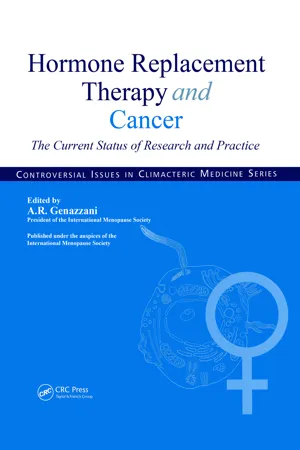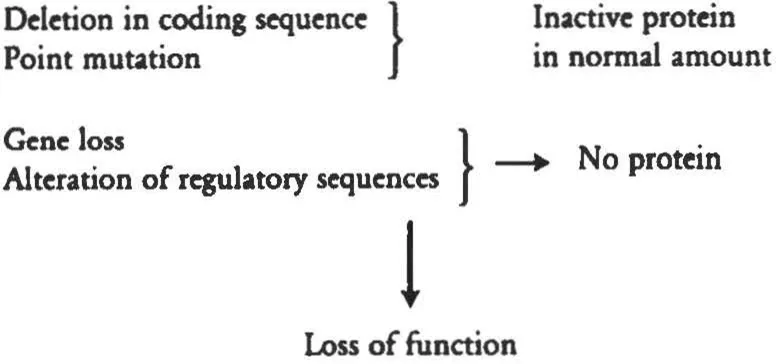
Hormone Replacement Therapy and Cancer
The Current Status of Research and Practice
Andrea R. Genazzani
- 296 Seiten
- English
- ePUB (handyfreundlich)
- Über iOS und Android verfügbar
Hormone Replacement Therapy and Cancer
The Current Status of Research and Practice
Andrea R. Genazzani
Über dieses Buch
The clinical benefits of hormone replacement therapy in women have to be carefully balanced against the possible risks, and a particular theoretical concern relates to risks associated with various forms of female oncology. Because of conflicting reports, gynecologists and oncologists especially need a single, authoritative resource of up-to-date information. Hormone Replacement Therapy and Cancer, published in association with the International Menopause Society, provides the very consensus statement that clinicians need in this difficult and complex area. Many of the world's leading specialists have contributed important chapters that provide state-of-the-art knowledge about the effects of hormones on women and possible cancer risks. The introductory section deals with carcinogenesis, and the other main sections cover HRT and breast cancer, endometrial cancer, colon cancer, melanoma and epithelial ovarian cancer. The concluding chapters discuss the benefits and risks of sp ecific therapies. An authoritative clinical reference with extensive bibliographic references and index, Hormone Replacement Therapy and Cancer covers all aspects of HRT and cancer based on the research available up to June 2001.
Häufig gestellte Fragen
Information
Oncogenes and tumor suppressor genes
1



(1) Point mutations or small deletions in the coding sequence, resulting in a constitutively activated protein;(2) Gene amplification, resulting in overexpression of the normal protein;(3) Chromosomal translocations, bringing the proto-oncogene under the control of an active promoter, causing inappropriate expression of the gene.

(1) Point mutations or small deletions in the coding sequence, resulting in a constitutively inactive protein;(2) Gene deletion, resulting in no expression of the protein;(3) Chromosomal translocations, leading to the formation of fusion proteins lacking their normal activity.

CLASSIFICATION OF ONCOGENES AND TUMOR SUPPRESSOR GENES
ONCOGENIC MUTATIONS AFFECTING CELL PROLIFERATION
Autocrine production of growth factors
Inhaltsverzeichnis
- Cover
- Half Title Page
- Title Page
- Copyright Page
- Table of Contents
- List of principal contributors
- 1 Oncogenes and tumor suppressor genes
- 2 Telomerase and cancer
- 3 Matrix metalloproteinases
- 4 Biological basis of angiogenesis and role of vascular endothelial growth factor-D
- 5 Breast cancer: epidemiology, pathology and natural history
- 6 Genes and heredity in breast cancer
- 7 Endocrine, paracrine and intracrine mechanisms of growth regulation in normal and malignant breast epithelium
- 8 Chemoprevention of breast cancer with tamoxifen: recent experience and future perspectives
- 9 Hormonal therapy of breast cancer
- 10 Hormone replacement therapy and mammographic breast density
- 11 Hormone replacement therapy, insulin-like growth factor I and breast cancer
- 12 Postmenopausal hormone use and breast cancer risk: reassessment of the evidence
- 13 The use of hormonal therapy for management of severe postmenopausal symptoms following breast cancer
- 14 Endometrial cancer: epidemiology, pathology and natural history
- 15 Endocrine, paracrine and intracrine mechanisms of growth regulation in normal and malignant endometrial epithelium
- 16 Chemoprevention and endocrine therapy of endometrial carcinoma
- 17 Hormone replacement therapy and endometrial cancer
- 18 Endometrial stromal tumors — are they hormonally sensitive?
- 19 Epidemiology of colorectal cancer
- 20 Colon cancer: pathology and natural history
- 21 Estrogen receptors, estrogens and colon cancer
- 22 Cyclo-oxygenase-2: an endogenous tumor promoter and target for the chemoprevention of colorectal cancer and other neoplastic diseases
- 23 Hormone replacement therapy and colon cancer
- 24 Cutaneous malignant melanoma: epidemiology, endocrine features and hormone replacement therapy
- 25 BRCA1-BRCA2 and ovarian cancer
- 26 Estrogen replacement therapy use and risk of ovarian cancer: results from two Italian studies and review of the literature
- 27 Understanding HRT risks and benefits and the new science of HRT
- 28 Pulsed estrogen therapy may lead to lower breast stimulation than with daily continuous estrogen exposure
- 29 Transdermal estrogen therapy and the risk of breast cancer: a clinical appraisal
- 30 The effects of selective estrogen receptor modulators on the endometrium
- 31 Safety and tolerability profile of Livial
- 32 Preclinical and clinical development of new progesterone receptor antagonists with high receptor specificity for breast cancer treatment
- 33 More than bones: hormone replacement therapy for mind and body
- Index